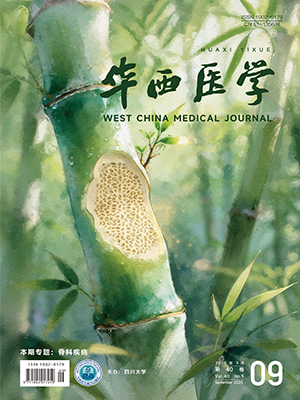| 1. |
胡付品. 251135株臨床分離菌株主要菌種分布(CHINET 2020)中國細菌耐藥監測網. (2020-09-01)[2021-01-03]. http://www.chinets.com/Data/AntibioticDrugFast.
|
| 2. |
Huang W, Qiao F, Zhang Y, et al. In-hospital medical costs of infections caused by carbapenem-resistant Klebsiella pneumoniae. Clin Infect Dis, 2018, 67(Suppl_2): S225-S230.
|
| 3. |
Chen Z, Xu Z, Wu H, et al. The impact of carbapenem-resistant Pseudomonas aeruginosa on clinical and economic outcomes in a Chinese tertiary care hospital: a propensity score-matched analysis. Am J Infect Control, 2019, 47(6): 677-682.
|
| 4. |
Lemos EV, De La Hoz FP, Alvis N, et al. Impact of carbapenem resistance on clinical and economic outcomes among patients with Acinetobacter baumannii infection in Colombia. Clin Microbiol Infect, 2014, 20(2): 174-180.
|
| 5. |
白艷玲, 杜明梅, 劉伯偉, 等. 感染/定植耐碳青霉烯類肺炎克雷伯菌住院患者周圍環境中分離CRKP菌株的流行特征. 中華醫院感染學雜志, 2018, 28(8): 1131-1134.
|
| 6. |
楊寶財, 苗勤, 劉海濤, 等. 我院ICU多重耐藥鮑曼不動桿菌聚集性病例與環境污染調查分析. 河北醫科大學學報, 2019, 40(11): 1317-1321.
|
| 7. |
Blazejewski C, Wallet F, Rouzé A, et al. Efficiency of hydrogen peroxide in improving disinfection of ICU rooms. Crit Care, 2015, 19(1): 30.
|
| 8. |
朱越獻, 干鐵兒, 徐虹, 等. 環境清潔措施對ICU高頻接觸物體表面多重耐藥菌檢出的影響. 中國消毒學雜志, 2016, 33(8): 735-738.
|
| 9. |
French GL, Otter JA, Shannon KP, et al. Tackling contamination of the hospital environment by methicillin-resistant Staphylococcus aureus (MRSA): a comparison between conventional terminal cleaning and hydrogen peroxide vapour decontamination. J Hosp Infect, 2004, 57(1): 31-37.
|
| 10. |
Boyce JM. Modern technologies for improving cleaning and disinfection of environmental surfaces in hospitals. Antimicrob Resist Infect Control, 2016, 5: 10.
|
| 11. |
Doll M, Morgan DJ, Anderson D, et al. Touchless technologies for decontamination in the hospital: a review of hydrogen peroxide and UV devices. Curr Infect Dis Rep, 2015, 17: 44.
|
| 12. |
Weber DJ, Kanamori H, Rutala W. “No touch” technologies for environmental decontamination: focus on ultraviolet devices and hydrogen peroxide systems. Curr Opin Infect Dis, 2016, 29(4): 424-431.
|
| 13. |
Higgins JPT, Green S. Cochrane handbook for systematic reviews of interventions Version 5.1.0. The Cochrane Collaboration, 2011. (2012-03-30)[2021-02-25]. http://www.cochrane-handbook.org.
|
| 14. |
Slim K, Nini E, Forestier D, et al. Methodological Index for Non-randomized Studies (MINORS): development and validation of a new instrument. ANZ J Surg, 2003, 73(9): 712-716.
|
| 15. |
曾憲濤, 劉慧, 陳曦, 等. Meta 分析系列之四: 觀察性研究的質量評價工具. 中國循證心血管醫學雜志, 2012, 4(4): 297-299.
|
| 16. |
Hardy KJ, Gossain S, Henderson N, et al. Rapid recontamination with MRSA of the environment of an intensive care unit after decontamination with hydrogen peroxide vapour. J Hosp Infect, 2007, 66(4): 360-368.
|
| 17. |
Horn K, Otter JA. Hydrogen peroxide vapor room disinfection and hand hygiene improvements reduce Clostridium difficile infection, methicillin-resistant Staphylococcus aureus, vancomycin-resistant Enterococci, and extended-spectrum β-lactamase. Am J Infect Control, 2015, 43(12): 1354-1356.
|
| 18. |
Jeanes A, Rao G, Osman M, et al. Eradication of persistent environmental MRSA. J Hosp Infect, 2005, 61(1): 85-86.
|
| 19. |
Mitchell BG, Digney W, Locket P, et al. Controlling methicillin-resistant Staphylococcus aureus (MRSA) in a hospital and the role of hydrogen peroxide decontamination: an interrupted time series analysis. BMJ Open, 2014, 4(4): e004522.
|
| 20. |
Otter JA, Cummins M, Ahmad F, et al. Assessing the biological efficacy and rate of recontamination following hydrogen peroxide vapour decontamination. J Hosp Infect, 2007, 67(2): 182-188.
|
| 21. |
Otter JA, Yezli S, Schouten M, et al. Hydrogen peroxide vapor decontamination of an intensive care unit to remove environmental reservoirs of multidrug-resistant gram-negative rods during an outbreak. Am J Infect Control, 2010, 38(9): 754-756.
|
| 22. |
Passaretti CL, Otter JA, Reich NG, et al. An evaluation of environmental decontamination with hydrogen peroxide vapor for reducing the risk of patient acquisition of multidrug-resistant organisms. Clin Infect Dis, 2013, 56(1): 27-35.
|




